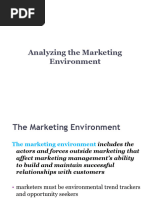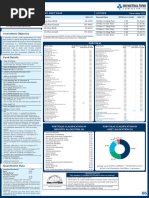0 ratings0% found this document useful (0 votes)
78 viewsModule 2 Environment
The document discusses the marketing environment and its impact on businesses. It describes the marketing environment as consisting of internal and external factors that influence a company's ability to serve its customers. The microenvironment includes suppliers, marketing intermediaries, customers, competitors, and publics. The macroenvironment comprises demographic, economic, natural, technological, political, and cultural forces in the larger society. It is dynamic and complex. Environmental scanning allows marketers to understand current conditions and adapt strategies accordingly. A business must monitor the environment continuously and respond proactively to manage threats and opportunities.
Uploaded by
Manjesh KumarCopyright
© © All Rights Reserved
Available Formats
Download as PPT, PDF, TXT or read online on Scribd
0 ratings0% found this document useful (0 votes)
78 viewsModule 2 Environment
The document discusses the marketing environment and its impact on businesses. It describes the marketing environment as consisting of internal and external factors that influence a company's ability to serve its customers. The microenvironment includes suppliers, marketing intermediaries, customers, competitors, and publics. The macroenvironment comprises demographic, economic, natural, technological, political, and cultural forces in the larger society. It is dynamic and complex. Environmental scanning allows marketers to understand current conditions and adapt strategies accordingly. A business must monitor the environment continuously and respond proactively to manage threats and opportunities.
Uploaded by
Manjesh KumarCopyright
© © All Rights Reserved
Available Formats
Download as PPT, PDF, TXT or read online on Scribd
You are on page 1/ 32
ENVIRONMENT
ENVIRONMENT AND YOU
BUSINESS
Goal Oriented Entity
Economic Performance
Profitability
Social Performance
Satisfaction of all interested parties
The Dynamic Marketing Environment
MARKETING
ENVIRONMENT
BUSINESS
Dynamic
Strategy
Continuous
monitoring
Evaluating Strategy
Redesign
ENVIRONMENT
Dynamic
Complex
Business cant act as a
closed system
Internal Factors &
External Factors
Elements of a Modern Marketing
System
Marketing presents a never ending
series of threats and opportunities
The Marketing Manager major task is
that of trend trackers and opportunity
seekers
- Changes in Computer Hardware/Software
- Changes in Consumer Durables
- Car Industry etc.
A Marketer has to design their
marketing strategy based on the
current marketing environment
ENVIRONMENTAL SCANNING
Environmental analysis
Extensive insight
Current market conditions
Impact of external factors that are
uncontrollable by the marketers
Nature of Marketing Environment
All the actors and forces influencing the
companys ability to transact business effectively
with its target market.
Includes:
Micro environment - forces close to the
company that affect its ability to serve its
customers.
Macro environment - larger societal forces
that affect the whole microenvironment.
The Marketing Environment
Company
Demographic
Economic
Natural
Technological
Political
Cultural
Company
Customers
Intermediaries
Suppliers
Competitors
Publics
The Microenvironment
Company
Customers
Publics
Suppliers
Competitors
Intermediaries
Forces Affecting a
Companys Ability to
Serve
Customers
The Microenvironment
Companys Internal Environment- functional
areas such as top management, finance, and
manufacturing, etc.
Suppliers - provide the resources needed to
produce goods and services.
Marketing Intermediaries - help the
company to promote, sell, and distribute its
goods to final buyers.
Customers - types of markets that purchase
a companys goods and services.
Competitors - those who serve a target
market with similar products and services.
Publics - any group that perceives itself
having an interest in a companys ability to
achieve its objectives.
The Macroenvironment
Demographic
Technological
Cultural
Economic
Political
Natural
Forces that Shape
Opportunities
and Pose Threats
to a Company
Demographic - monitors population in terms of
age, sex, race, occupation, location and other
statistics.
Economic - factors that affect consumer buying
power and patterns.
Natural - natural resources needed as inputs by
marketers or that are affected by marketing
activities.
Technological - forces that create new product
and market opportunities.
Political - laws, agencies and groups that
influence or limit marketing actions.
Cultural - forces that affect a societys basic
values, perceptions, preferences, and behaviors.
The Macroenvironment
Demographic Environment
Size of the population
Its geographic distribution
Density
Mobility trends
Age Distribution
Birth
Marriages
The Macroenvironment
Key Demographic Trends
Changing household
Geographic population shifts
Better-educated, more private
workforce
Increasing Diversity
Indias Demographic Time Bomb
Every minute birth of 54 babies
Every week a population of
Chandigarh is added
Every eighth month one Australia is
added
The teenagers Market and working womens
market have created enormous marketing
opportunities in India
Examples: Mobile Phones, Twowheelers,
Cosmetics, Fast Food, Ready to Eat &
Electronics
The Macroenvironment
The Economic Environment
Consists of factors that affect consumer
purchasing power and spending patterns
Total buying power is a function of
current income, prices, savings, and credit
availability
The monetary policy changes, prevailing
interest rates, business cycles, changes in
income levels
Marketers should be aware of four main trends
in the economic environment:
Slowdown in real income growth
Continued Inflationary pressure
Low savings
Changing Consumer Expenditure Pattern
The Macroenvironment
The Natural Environment
Concern for the natural environment has grown
steadily, increasing the importance of these
trends:
Shortage of raw materials
Increased pollution
Increased governmental intervention
The Macroenvironment
Key Technological Trends
The technological environment is
characterized by rapid change.
New technologies create new
opportunities and markets but make old
technologies obsolete.
The U.S. leads the world in research and
development spending.
The Macroenvironment
The Political Environment
Includes laws, governmental agencies, and
pressure groups that impact organizations and
individuals. Key trends include:
Increased legislation to protect businesses
as well as consumers.
Changes in governmental agency
enforcement.
Increased emphasis on ethical behavior and
social responsibility.
The Macroenvironment
The Cultural Environment
Is composed of institutions and other
forces that affect a societys basic values,
perceptions, preferences, and behaviors.
Culture can influence decision making.
Core beliefs are persistent; secondary
cultural values change and shift more
easily.
The cultural values of a society are
expressed through peoples views.
Cultural values are expressed
via how people view:
The Macroenvironment
Themselves
Others
Organizations
Society
Nature
The Universe
Responding to the Marketing
Environment
Reactive: Passive Acceptance and
Adaptation
Companies design strategies that
avoid threats and capitalize upon
opportunities.
Proactive: Environmental Management
Responding to the
Marketing Environment
Environmental Management
Perspective
Taking a proactive approach to
managing the microenvironment
and the macroenvironment to
affect changes that are favorable
for the company.
You might also like
- Topic 3 - Chapter 3 Analysing the Marketing Environment (1)No ratings yetTopic 3 - Chapter 3 Analysing the Marketing Environment (1)34 pages
- Marketing Management - BA3602: Nabeel Farooq Nabeel - Farooq@szabist-Isb - Edu.pkNo ratings yetMarketing Management - BA3602: Nabeel Farooq Nabeel - Farooq@szabist-Isb - Edu.pk37 pages
- IM1019 L2 Analyzing The Marketing EnvironmentNo ratings yetIM1019 L2 Analyzing The Marketing Environment36 pages
- 1.1 Analyzing The Marketing EnvironmentNo ratings yet1.1 Analyzing The Marketing Environment28 pages
- Lecture 6 - Marketing Environment - Micro & Macro100% (1)Lecture 6 - Marketing Environment - Micro & Macro21 pages
- The Marketing Environment of A Company Is Composed of The People - pdf.06No ratings yetThe Marketing Environment of A Company Is Composed of The People - pdf.069 pages
- Chapter#3: Analyzing The Marketing EnvironmentNo ratings yetChapter#3: Analyzing The Marketing Environment23 pages
- Pertemuan 03 - Analyzing The Marketing EnvironmentNo ratings yetPertemuan 03 - Analyzing The Marketing Environment38 pages
- Marketing Environment: Macro & Micro Factors Affecting BusinessNo ratings yetMarketing Environment: Macro & Micro Factors Affecting Business20 pages
- Chapter 2 Analyzing The Marketing EnvironmentNo ratings yetChapter 2 Analyzing The Marketing Environment28 pages
- Marketing Environment Notes Class 11 CBSENo ratings yetMarketing Environment Notes Class 11 CBSE5 pages
- Presentation On Marketing Environment: Presented To: Prof. Vipul PatelNo ratings yetPresentation On Marketing Environment: Presented To: Prof. Vipul Patel36 pages
- Dasara Elephants' Profile: Name Info CharacteristicsNo ratings yetDasara Elephants' Profile: Name Info Characteristics2 pages
- Executive Summary: Performance of PortfolioNo ratings yetExecutive Summary: Performance of Portfolio65 pages
- Dasara Elephants' Profile: Name Info CharacteristicsNo ratings yetDasara Elephants' Profile: Name Info Characteristics2 pages
- Questionnaire FR The Wagae and Salary AdministrtaionNo ratings yetQuestionnaire FR The Wagae and Salary Administrtaion2 pages
- Knowledge Sharing Communities of PracticesNo ratings yetKnowledge Sharing Communities of Practices9 pages
- Definition - Empowering Others On A TeamNo ratings yetDefinition - Empowering Others On A Team3 pages
- SBI Flexicap Fund Factsheet October 2024No ratings yetSBI Flexicap Fund Factsheet October 20241 page
- Law On Foreign Investments in The Republic of MaldivesNo ratings yetLaw On Foreign Investments in The Republic of Maldives3 pages
- 4634 - POS - AnnualReport - 2017-03-31 - Pos Malaysia 2017 (Part 2) - 462009214No ratings yet4634 - POS - AnnualReport - 2017-03-31 - Pos Malaysia 2017 (Part 2) - 462009214195 pages
- 30 Senior Loan Officer Interview Questions and AnswersNo ratings yet30 Senior Loan Officer Interview Questions and Answers17 pages
- Internal and External Growth Strategies PDF100% (1)Internal and External Growth Strategies PDF5 pages
- Introduction To E-Floral Business ManagementNo ratings yetIntroduction To E-Floral Business Management8 pages
- BUSS40005 Social Enterprise 02 Assignment 2No ratings yetBUSS40005 Social Enterprise 02 Assignment 28 pages
- Topic 3 - Chapter 3 Analysing the Marketing Environment (1)Topic 3 - Chapter 3 Analysing the Marketing Environment (1)
- Marketing Management - BA3602: Nabeel Farooq Nabeel - Farooq@szabist-Isb - Edu.pkMarketing Management - BA3602: Nabeel Farooq Nabeel - Farooq@szabist-Isb - Edu.pk
- The Marketing Environment of A Company Is Composed of The People - pdf.06The Marketing Environment of A Company Is Composed of The People - pdf.06
- Pertemuan 03 - Analyzing The Marketing EnvironmentPertemuan 03 - Analyzing The Marketing Environment
- Marketing Environment: Macro & Micro Factors Affecting BusinessMarketing Environment: Macro & Micro Factors Affecting Business
- Presentation On Marketing Environment: Presented To: Prof. Vipul PatelPresentation On Marketing Environment: Presented To: Prof. Vipul Patel
- Dasara Elephants' Profile: Name Info CharacteristicsDasara Elephants' Profile: Name Info Characteristics
- Dasara Elephants' Profile: Name Info CharacteristicsDasara Elephants' Profile: Name Info Characteristics
- Questionnaire FR The Wagae and Salary AdministrtaionQuestionnaire FR The Wagae and Salary Administrtaion
- Law On Foreign Investments in The Republic of MaldivesLaw On Foreign Investments in The Republic of Maldives
- 4634 - POS - AnnualReport - 2017-03-31 - Pos Malaysia 2017 (Part 2) - 4620092144634 - POS - AnnualReport - 2017-03-31 - Pos Malaysia 2017 (Part 2) - 462009214
- 30 Senior Loan Officer Interview Questions and Answers30 Senior Loan Officer Interview Questions and Answers







































































































